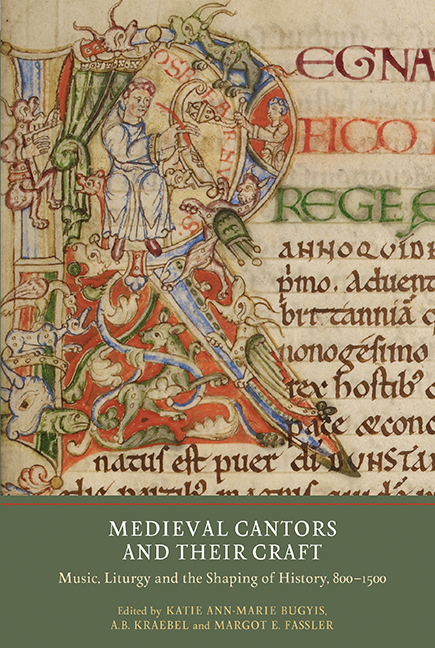Book contents
- Frontmatter
- Dedication
- Contents
- List of Illustrations
- Contributors
- Acknowledgments
- Abbreviations
- Miscellaneous Frontmatter
- Introduction
- PART I The Carolingian Period
- PART II The Eleventh Century
- PART III England in the Twelfth Century
- PART IV On the Continent: Five Case Studies
- 15 The Cantors of the Holy Sepulchre and their Contribution to Crusade History and Frankish Identity
- 16 Shaping Liturgy, Shaping History: A Cantor-Historian from Twelfth-Century Peterhausen
- 17 The Roman Liturgical Tradition According to a Twelfth-Century Roman Cantor
- 18 A Life in Hours: Goswin of Bossut's Office for Arnulf of Villers
- 19 Writing History to Make History: Johannes Meyer's Chronicles of Reform
- Index of Manuscripts
- General Index
- Miscellaneous Endmatter
15 - The Cantors of the Holy Sepulchre and their Contribution to Crusade History and Frankish Identity
from PART IV - On the Continent: Five Case Studies
Published online by Cambridge University Press: 25 October 2017
- Frontmatter
- Dedication
- Contents
- List of Illustrations
- Contributors
- Acknowledgments
- Abbreviations
- Miscellaneous Frontmatter
- Introduction
- PART I The Carolingian Period
- PART II The Eleventh Century
- PART III England in the Twelfth Century
- PART IV On the Continent: Five Case Studies
- 15 The Cantors of the Holy Sepulchre and their Contribution to Crusade History and Frankish Identity
- 16 Shaping Liturgy, Shaping History: A Cantor-Historian from Twelfth-Century Peterhausen
- 17 The Roman Liturgical Tradition According to a Twelfth-Century Roman Cantor
- 18 A Life in Hours: Goswin of Bossut's Office for Arnulf of Villers
- 19 Writing History to Make History: Johannes Meyer's Chronicles of Reform
- Index of Manuscripts
- General Index
- Miscellaneous Endmatter
Summary
The Western Christians who arrived to Jerusalem in June 1099 came as conquerors intent on freeing the holy places from Muslim rule. When they succeeded in taking Jerusalem on 15 July, they inflicted damage not only to Jerusalem's walls and buildings, but also to its existing social and religious infrastructure, slaughtering or expelling Jerusalem's Muslim and Jewish inhabitants, electing their own secular and religious rulers and appropriating most of the holy shrines of the city. They also suppressed the rights of their co-religionists; the first act of the new Latin patriarch Arnulf of Chocques was to drive the Orthodox Christians out of the Holy Sepulchre and place the church entirely under the control of Latin clergy. It was these very clergy, however – especially the cantors of the Holy Sepulchre Ansellus ‘de Turre’, Giraldus, Bernardus, Peter and Bartholomeus – who contributed significantly throughout the twelfth century to the reconstruction of Jerusalem and its fractured society. The cantors’ tool in this regard was the liturgy, especially a new feast adopted by the canons of the Holy Sepulchre early in the century, the Festivitas sancte Hierusalem. This feast, celebrated annually on 15 July in commemoration of the capture, presented a new vision of Crusade history. It referred explicitly to the capture by combining chants from the Latin liturgical repertory with selections from the Historia Hierosolymitana of Fulcher of Chartres, and it presented the conquest as the restoration of Jerusalem foretold in the Old Testament and the descent of the Heavenly Jerusalem foreseen by the Apostle John. This liturgical recasting of Crusade history had specific implications for Frankish identity, making the Franks the foretold vessels of God's saving power, liberators and heralds of the New Jerusalem. Yet the Frankish identity constructed through the liturgy was not entirely stable, and the Jerusalem feast underwent two full revisions in the twelfth century. In the second version, the Franks were depicted as Jerusalem's righteous watchmen, while the third version portrayed the Franks as ordained ministers of Jerusalem, with the city interpreted as the Church. Insofar as these liturgically constructed views of the Franks had the potential to be transformative, shaping Crusader identity through the power of ritual performance, the cantors of the Holy Sepulchre can be considered some of the most influential history-writers and social architects of twelfthcentury Jerusalem.
- Type
- Chapter
- Information
- Medieval Cantors and their CraftMusic, Liturgy and the Shaping of History, 800-1500, pp. 278 - 296Publisher: Boydell & BrewerPrint publication year: 2017



